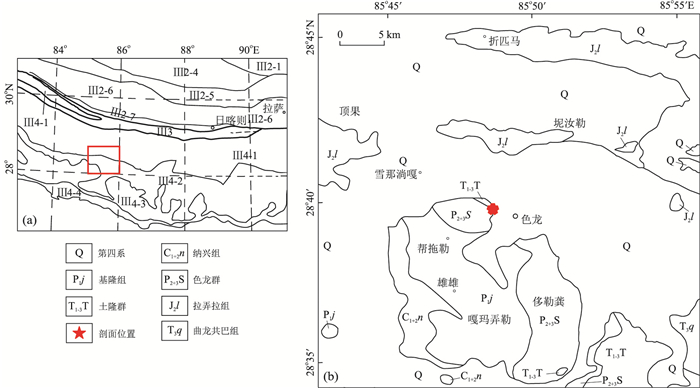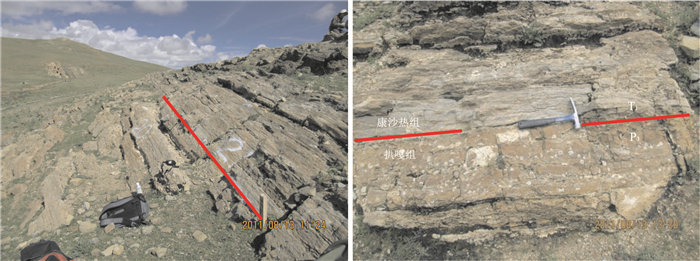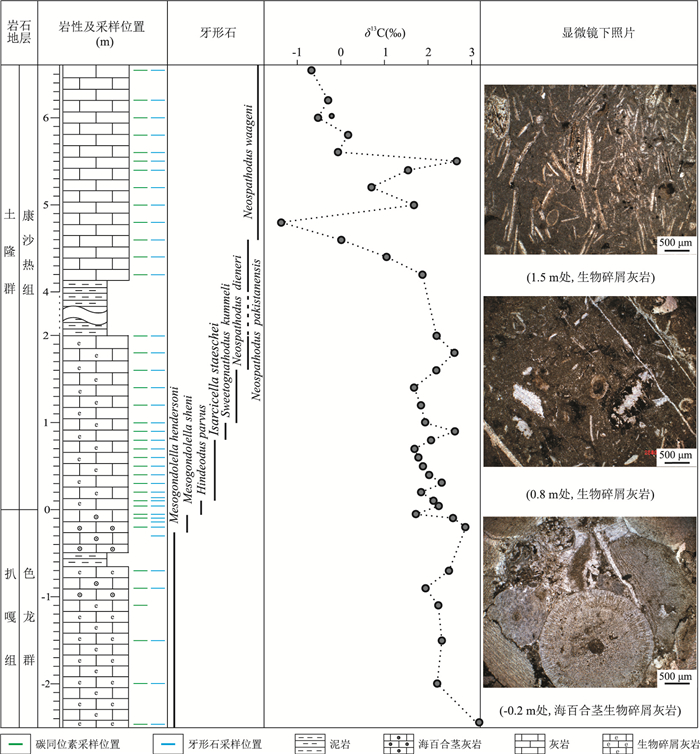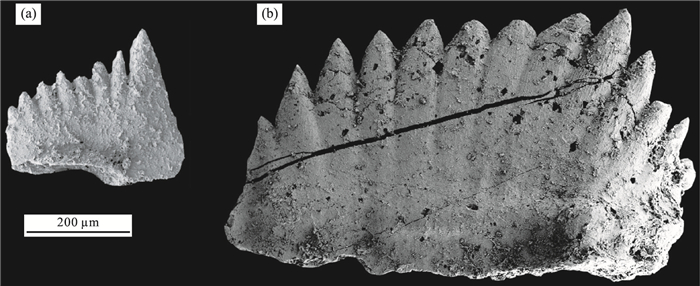Stable Carbon Isotope Characteristics of Permian-Triassic Boundary at the Selong Xishan Section
-
摘要: 古生代-中生代之交的生物灭绝过程和原因一直是科学家关注和致力解决的关键古生物学问题之一.色龙西山剖面的牙形石分带工作取得了重要进展,为认识该地区地层序列和沉积历史提供了新的证据.全岩碳同位素分析表明,在长兴阶与印度阶附近该剖面存在着碳同位素负偏,可以同我国华南多个剖面进行对比,揭示了古生代-中生代之交的碳同位素变化和生物灭绝模式具有全球对比性.新识别出的奥伦尼克阶底部(Neospathodus waageni带底部)碳同位素值大幅度负偏及之后的正偏,与华南等地的变化规律一致,反映了二叠纪末期到早三叠世长期的、复杂的生物和环境变化过程.Abstract: The process and cause about the mass extinction event across the Paleozoic-Mesozoic transition have always been one of the key paleontological issues in the past few decades. The conodont zoning of the Selong Xishan section has made important progress, providing new evidence for understanding the stratigraphic sequence and sedimentary history of the area. Carbon isotope analyses of bulk samples in this study indicate that there are negative shifts across the Changshingian-Induan Boundary, which are comparable to South China. Newly identified carbon isotope negative shift at earliest Olenekian, base of Neospathodus waageni zone and the following positive shift coincide with the pattern recognized in South China and other places, implying the multi-phase extinction-recovery processes in Early Triassic.
-
Key words:
- carbon isotope /
- Permian-Triassic /
- conodont /
- Selong Xishan /
- biostratigraphy /
- geochemistry /
- stratigraphy
-
图 1 西藏色龙地区地质图及构造位置
据潘桂棠等(2002)修改.Ⅲ2.拉达克-冈底斯-拉萨-腾冲陆块;Ⅲ2-1.昂龙岗日-班戈-腾冲燕山期岩浆弧带;Ⅲ2-4.革吉-措勤晚古生代复合弧后盆地带;Ⅲ2-5.隆格尔-工布江达断隆带;Ⅲ2-6.冈底斯-下察隅晚燕山-喜马拉雅期岩浆弧带;Ⅲ2-7.冈底斯南缘弧前盆地带;Ⅲ3.印度河-雅鲁藏布江结合带;Ⅲ4.印度陆块;Ⅲ4-1.北喜马拉雅特提斯沉积褶冲带;Ⅲ4-2.高喜马拉雅结晶岩带或基底逆冲带;Ⅲ4-3.低喜马拉雅褶冲带;Ⅲ4-4.锡瓦利克厚造山前陆盆地带
Fig. 1. The geological map and tectonic framework of Selong area, Tibet
图 3 西藏色龙西山剖面牙形石生物地层及δ13CPDB变化曲线
牙形石带划分方案据Yuan et al.(2018)修改
Fig. 3. Conodont biostratigraphy and curves of δ13CPDB at the Selong Xishan section, Tibet
图 5 西藏色龙西山剖面与我国华南等地剖面δ13CPDB对比
其余剖面的碳同位素值来自Tong et al.(2007)
Fig. 5. Correlation of δ13CPDB between the Selong Xishan section and other well-studied Lower Triassic sections in South China
表 1 色龙西山剖面δ13CPDB和δ18OPDB同位素值测试结果
Table 1. The contents of δ13CPDB and δ18OPDB at the Selong Xishan section, Tibet
样品 δ13CPDB(‰) δ18OPDB(‰) TWS(6.55 m) -0.675 -10.790 TWS(6.2 m) -0.292 -13.330 TWS(6.0 m) -0.524 -15.480 TWS(5.8 m) 0.166 -12.598 TWS(5.6 m) -0.066 -14.623 TWS(5.5 m) 2.658 -11.960 TWS(5.4 m) 1.543 -13.417 TWS(5.2 m) 0.703 -12.420 TWS(5.0 m) 1.677 -12.564 TWS(4.8 m) -1.465 -19.436 TWS(4.6m) 0.010 -17.250 TWS(4.4m) 1.048 -17.279 TWS(4.2m) 1.872 -16.835 TWS(2.0m) 2.197 -13.831 TWS(1.8m) 2.606 -13.637 TWS(1.6m) 2.190 -13.491 TWS(1.4m) 1.679 -14.679 TWS(1.2m) 1.838 -14.122 TWS(1.0m) 1.937 -13.604 TWS(0.9 m) 2.616 -11.843 TWS(0.8 m) 2.069 -12.972 TWS(0.7 m) 1.697 -13.673 TWS(0.6 m) 1.779 -13.649 TWS(0.5 m) 1.879 -13.753 TWS(0.4 m) 2.026 -12.213 TWS(0.3 m) 2.327 -13.062 TWS(0.2 m) 1.841 -13.069 TWS(0.1 m) 2.125 -13.451 TWS(0.05 m) 2.246 -11.489 TWS(-0.05 m) 1.707 -14.833 TWS(-0.1m) 2.572 -8.907 TWS(-0.2m) 2.869 -10.305 TWS(-0.7m) 2.480 -14.065 TWS(-0.9m) 1.943 -14.371 TWS(-1.1m) 2.236 -15.273 TWS(-1.5m) 2.317 -14.955 TWS(-2.0m) 2.210 -13.206 TWS(-2.5m) 3.150 -13.351 -
Brühwiler, T., Goudemand, N., Galfetti, T., et al., 2009.The Lower Triassic Sedimentary and Carbon Isotope Records from Tulong (South Tibet) and Their Significance for Tethyan Palaeoceanography.Sedimentary Geology, 222(3-4):314-332. https://doi.org/10.1016/j.sedgeo.2009.10.003 Cao, C.Q., Wang, W., Jin, Y., 2002.Carbon Isotope Variation near the Boundary of the Permian-Triassic in Meishan, Zhejiang.Chinese Science Bulletin, 47(4):302-306 (in Chinese). doi: 10.1360/02tb9072 Cui, Y., Liu, J.B.Jiang, Q.Y.Y., 2009.Fluctuations of Stable Carbon Isotopes around the Permian-Triassic Boundary in Huaying of Sichuan, South China:Its Characteristics and Biogeochemical Origin.Acta Scientiarum Naturalium Universitatis Pekinensis, 45(3):461-471 (in Chinese with English abstract). Hu, X.M., Wang, C.S., Li, X.H., 2001.Stable Carbon Isotope Response to Oceanic Anoxic Events.Journal of Chengdu University of Technology, 28(1):1-6 (in Chinese with English abstract). http://www.wanfangdata.com.cn/details/detail.do?_type=perio&id=cdlgxyxb200101001 Huang, K.K., Huang, S.J., Lan, Y.F., et al., 2013.Review of the Carbon Isotope of Early Triassic Carbonates.Advance in Earth Sciences, 28(3):357-365 (in Chinese with English abstract). http://d.old.wanfangdata.com.cn/Periodical/dqkxjz201303007 Isozaki, Y., 1997.Permo-Triassic Boundary Superanoxia and Stratified Superocean:Records from Lost Deep Sea.Science, 276(5310):235-238. https://doi.org/10.1126/science.276.5310.235 Li, Y.C., Zhou, Z.Z., 2002.Massive Dissociation of Gas Hydrate during Oceanic Anoxia as a Cause of Mass Extinction at the End of Permian.Geology-Geochemistry, 30(1):57-63 (in Chinese with English abstract). http://www.wanfangdata.com.cn/details/detail.do?_type=perio&id=dzdqhx200201010 Liang, H.D., Liang, Y.C., 2004.Observation and Determination of Residue Acid Trapped in the White Clay near Permian-Triassic Boundary of the Meishan Section in South China.Science Technology and Engineering, 4(1):7-11 (in Chinese with English abstract). http://www.wanfangdata.com.cn/details/detail.do?_type=perio&id=kxjsygc200401003 Magaritz, M., Krishnamurthy, R.V., Holser, W.T., 1992.Parallel Trends in Organic and Inorganic Carbon Isotopes across the Permian/Triassic Boundary.American Journal of Science, 292(10):727-739. https://doi.org/10.2475/ajs.292.10.727 Pan, G.T., Li, X.Z., Wang, L.Q., et al., 2002.Preliminary Division of Tectonic Units of the Qinghai-Tibet Plateau and Its Adjacent Regions.Regional Geology of China, 21(11):701-707 (in Chinese with English abstract). http://www.wanfangdata.com.cn/details/detail.do?_type=perio&id=zgqydz200211002 Payne, J.L., Lehrmann, D.J., Wei, J.Y., et al., 2004.Large Perturbations of the Carbon Cycle during Recovery from the End-Permian Extinction.Science, 305(5683):506-509. https://doi.org/10.1126/science.1097023 Payne, J.L., Turchyn, A.V., Paytan, A., et al., 2010.Calcium Isotope Constraints on the End-Permian Mass Extinction.Proceedings of the National Academy of Sciences, 107(19):8543-8548. https://doi.org/10.1073/pnas.0914065107 Renne, P.R., Black, M.T., Zichao, Z., et al., 1995.Synchrony and Causal Relations between Permian-Triassic Boundary Crises and Siberian Flood Volcanism.Science, 269(5229):1413-1416. https://doi.org/10.1126/science.269.5229.1413 Riccardi, A., Kump, L.R., Arthur, M.A., et al., 2007.Carbon Isotopic Evidence for Chemocline Upward Excursions during the End-Permian Event.Palaeogeography, Palaeoclimatology, Palaeoecology, 248(1-2):73-81. https://doi.org/10.1016/j.palaeo.2006.11.010 Shi, G.R., Shen, S.Z., N.W.Archbold, 1999.Gruntea gen.nov., A New Permian Spirigerellid (Brachiopoda) Genus From Selong, Southern Tibet, China.Acta Palaeontologica Sinica, 38(3):346-352 (in Chinese with English abstract). Song, H.J., Tong, J.N., Xiong, Y.L., et al., 2012.The Large increase of δ13Ccarb-Depth Gradient and the End-Permian Mass Extinction.Science in China(Series D), 42(8):1182-1191(in Chinese). http://www.cnki.com.cn/Article/CJFDTotal-JDXG201207005.htm Song, H.J., Tong, J.N., 2016.Mass Extinction and Survival during the Permina-Triassic Crisis.Earth Science, 41(6):901-918. https://doi.org/10.3799/dqkx.2016.077 Song, H.J., Tong, J.N., Algeo, T.J., et al., 2013.Large Vertical δ13CDIC Gradients in Early Triassic Seas of the South China Craton:Implications for Oceanographic Changes Related to Siberian Traps Volcanism.Global and Planetary Change, 105:7-20. https://doi.org/10.1016/j.gloplacha.2012.10.023 Shen, S.Z., Archbold, N.W., Shi, G.R., et al., 2000.Permian Brachiopods from the Selong Xishan Section, Xizang (Tibet), China Part 1:Stratigraphy, Strophomenida, Productida and Rhynchonellida.Geobios, 33(6):725-752. https://doi.org/10.1016/s0016-6995(00)80125-4 Shen, S.Z., Cao, C.Q., Henderson, C.M., et al., 2006.End-Permian Mass Extinction Pattern in the Northern Peri-Gondwanan Region.Palaeoworld, 15(1):3-30. https://doi.org/10.1016/j.palwor.2006.03.005 Shen, S.Z., Crowley, J.L., Wang, Y., et al., 2011.Calibrating the End-Permian Mass Extinction.Science, 334(6061):1367-1372. https://doi.org/10.1126/science.1213454 Shen, S.Z., Jin, Y.G., 1999.Brachiopods from the Permian-Triassic Boundary Beds at the Selong Xishan Section, Xizang (Tibet), China.Journal of Asian Earth Sciences, 17(4):547-559. https://doi.org/10.1016/s1367-9120(99)00004-8 Tian, L., Tong, J.N., Sun, D.Y., et al., 2014.The Microfacies and Sedimentary Responses to the Mass Extinction during the Permian-Triassic Transition at Yangou Section, Jiangxi Province, South China.Science China Earth Sciences, 57(9):2195-2207. https://doi.org/10.1007/s11430-014-4869-5 Tong, J.N., Zuo, J.X., Chen, Z.Q, 2007.Early Triassic Carbon Isotope Excursions from South China:Proxies for Devastation and Restoration of Marine Ecosystems Following the End-Permian Mass Extinction.Geological Journal, 42(3-4):371-389. https://doi.org/10.1002/gj.1084 Wang, L.N., Wignall, P.B., Sun, Y.D., et al., 2017.New Permian-Triassic Conodont Data from Selong (Tibet) and the Youngest Occurrence of Vjalovognathus.Journal of Asian Earth Sciences, 146:152-167. https://doi.org/10.13039/501100001809 Wang, W., Shen, S.Z., Zhu, Z.L., 1997.Carbon-Isotope Characteristic of the Permian-Triassic Boundary Selong Section, Xizang(Tibet), China and Its Significance.Chinese Science Bulletin, 42(4):406-408 (in Chinese). https://www.researchgate.net/publication/311709269_Carbon-isotope_characteristic_of_the_Permian-Triassic_boundary_Selong_section_Xizang_Tibet_China_and_its_significance Wang, Z.H., Wang, Y.G., 1995.Permian-Lower Triassic Conodonts from Selong Xishan of Nyalam, S.Tibet, China.Acta Micropalaeontologica Sinica, 12(4):333-348 (in Chinese with English abstract). http://www.wanfangdata.com.cn/details/detail.do?_type=perio&id=QK199500519315 Wignall, P.B., Twitchett, R.J., 1996.Oceanic Anoxia and the End Permian Mass Extinction.Science, 272(5265):1155-1158. https://doi.org/10.1126/science.272.5265.1155 Xia, F.S., Zhang, B.G., 1992.Age of the Selong Group in Xishan, Selong of Xizang and the Permian-Triassic Boundary.Journal of Stratigraphy, 16(4):256-263 (in Chinese). Xu, D.Y., Yan, Z., 1993.Carbon Isotope and Iridium Event Markers near the Permian/Triassic Boundary in the Meishan Section, Zhejiang Province, China.Palaeogeography, Palaeoclimatology, Palaeoecology, 104(1-4):171-176. https://doi.org/10.1016/0031-0182(93)90128-6 Xie, S.C., Pancost, R.D., Huang, J.H., et al., 2007.Changes in the Global Carbon Cycle Occurred as Two Episodes during the Permian-Triassic Crisis.Geology, 35(12):1083-1086. https://doi.org/10.1130/g24224a.1 Yao, J.X., Li, Z., 1987.Permian-TriassicConodont Faunas and the Permian-Triassic Boundary at the Selong Section in Nyalam County, Xizang, China.Chinese Science Bulletin, 32(22):1555-1560. http://kns.cnki.net/KCMS/detail/detail.aspx?filename=JXTW198722008&dbname=CJFD&dbcode=CJFQ Yin, H.F., Huang, S.J., Zhang, K.X., et al., 1989.VolcanicActivity at the Turn of the Permian-Triassic in South China and Its Impact on Biological Extinction.Journal of Geology, 62(2):169-181 (in Chinese). Yin, H.F., Jiang, H.S., Xia, W.C., et al., 2014.The End-Permian Regression in South China andIts Implication on Mass Extinction.Earth-Science Reviews, 137:19-33. https://doi.org/10.1016/j.earscirev.2013.06.003 Yin, H.F., Xie, S.C., Luo, G.M., et al., 2012.Two Episodes of Environmental Change at the Permian-Triassic Boundary of the GSSP Section Meishan.Earth-Science Reviews, 115(3):163-172. https://doi.org/10.1016/j.earscirev.2012.08.006 Yuan, D.X., Zhang, Y.C., Shen, S.Z., 2018.Conodont Succession and Reassessment of Major Events around the Permian-Triassic Boundary at the Selong Xishan Section, Southern Tibet, China.Global and Planetary Change, 161:194-210. https://doi.org/10.13039/501100001809 Zhang, B.G., 1974.The Stratigraphic of the Mount Qomolangma Area-Permian, Scientific Expedition Report in Mount Qomolangma Area (1966-1968).Science Press, Beijing (in Chinese). Zhang, S.X., Jin, Y.G., 1976.Upper Palaeozoic Brachiopod Fossils in Mount Qomolangma Area.Science Press, Beijing (in Chinese). Zhu, T.X., Zhou, M.K., Feng, X.T., et al., 2005.Phanerozoic Multiple Strata and Basin Evolution on the Northern Slope of Himalaya, Tibet.Geological Publishing House, Beijing (in Chinese). Zuo, J.X., Tong, J.N., Qiu, H.O., et al., 2003.Carbon and Oxygen Isotopic Stratigraphic Correlation and Its Paleoenvironment Significance during the Lower Triassic, Chaohu, Anhui Province, China.Geology-Geochemistry, 31(3):26-33 (in Chinese with English abstract). http://www.wanfangdata.com.cn/details/detail.do?_type=perio&id=dzdqhx200303005 Zuo, J.X., Tong, J.N., Qiu, H.O., et al., 2004.Carbon and Oxygen Isotope Stratigraphy of the Lower Triassic at Northern Pingdingshan Section of Chaohu, Anhui Province, China.Journal of Stratigraphy, 28(1):35-40, 47 (in Chinese with English abstract). http://www.wanfangdata.com.cn/details/detail.do?_type=perio&id=dcxzz200401004 曹长群, 王伟, 金玉, 2002.浙江煤山二叠-三叠系界线附近碳同位素变化.科学通报, 47(4):302-306. doi: 10.3321/j.issn:0023-074X.2002.04.014 崔莹, 刘建波, 江崎洋一, 2009.四川华蓥二叠-三叠系界线剖面稳定碳同位素变化特征及其生物地球化学循环成因.北京大学学报(自然科学版), 45(3):461-471. doi: 10.3321/j.issn:0479-8023.2009.03.015 胡修棉, 王成善, 李祥辉, 2001.大洋缺氧事件的碳稳定同位素响应.成都理工学院学报, 28(1):1-6. doi: 10.3969/j.issn.1671-9727.2001.01.001 黄可可, 黄思静, 兰叶芳, 等, 2013.早三叠世海相碳酸盐碳同位素研究进展.地球科学进展, 28(3):357-365. http://d.old.wanfangdata.com.cn/Periodical/dqkxjz201303007 李玉成, 周忠泽, 2002.华南二叠纪末缺氧海水中的有毒气体与生物集群绝灭.地质地球化学, 30(1):57-63. doi: 10.3969/j.issn.1672-9250.2002.01.010 梁汉东, 梁言慈, 2004.中国煤山剖面二叠系/三叠系界线附近白粘土中残余酸的发现与意义.科学技术与工程, 4(1):7-11. doi: 10.3969/j.issn.1671-1815.2004.01.003 潘桂棠, 李兴振, 王立全, 等, 2002.青藏高原及邻区大地构造单元初步划分.地质通报, 21(11):701-707. doi: 10.3969/j.issn.1671-2552.2002.11.002 石光荣, 沈树忠, N.W.Archbold, 1999.西藏南部色龙二叠纪腕足动物携螺贝类——新属:Gruntea gen.nov..古生物学报, 38(3):346-352. doi: 10.3969/j.issn.0001-6616.1999.03.005 宋海军, 童金南, 熊炎林, 等, 2012.δ13Ccarb-深度梯度的剧增与二叠纪末生物大灭绝.中国科学(D辑), 42(8):1182-1191. http://d.old.wanfangdata.com.cn/Conference/7858007 宋海军, 童金南, 2016二叠纪-三叠纪之交生物大灭绝与残存.地球科学, 41(6):901-918. https://doi.org/10.3799/dqkx.2016.077 王志浩, 王义刚, 1995.中国西藏聂拉木色龙西山二叠系-下三叠统牙形刺.微体古生物学报, 12(4):333-348. http://www.wanfangdata.com.cn/details/detail.do?_type=perio&id=QK199500519315 王伟, 沈树忠, 朱自力, 1997.中国西藏色龙二叠系-三叠系界线剖面的碳同位素特征及其意义.科学通报, 42(4):406-408. doi: 10.3321/j.issn:0023-074X.1997.04.022 夏凤生, 章炳高, 1992.西藏色龙西山色龙群的时代及二叠系与三叠系的界线.地层学杂志, 16(4):256-263. http://www.wanfangdata.com.cn/details/detail.do?_type=perio&id=QK000000162341 殷鸿福, 黄思骥, 张克信, 等, 1989.华南二叠-三叠纪之交的火山活动及其对生物灭绝的影响.地质学报, 62(2):169-181. doi: 10.3321/j.issn:0001-5717.1989.02.002 章炳高, 1974.珠穆朗玛峰地区的地层——二叠系, 珠穆朗玛峰地区科学考察报告(1966-1968).北京:科学出版社. 张守信, 金玉玕, 1976.珠穆朗玛峰地区上古生界腕足动物化石.北京:科学出版社. 朱同兴, 周铭魁, 冯心涛, 等, 2005.西藏喜马拉雅北坡显生宙多重地层与盆地演化.北京:地质出版社. 左景勋, 童金南, 邱海鸥, 等, 2003.巢湖地区早三叠世碳氧同位素地层对比及其古生态环境意义.地质地球化学, 31(3):26-33. doi: 10.3969/j.issn.1672-9250.2003.03.005 左景勋, 童金南, 邱海鸥, 等, 2004.巢湖平顶山北坡剖面早三叠世碳、氧同位素地层学研究.地层学杂志, 28(1):35-40, 47. doi: 10.3969/j.issn.0253-4959.2004.01.004 -










 下载:
下载:





